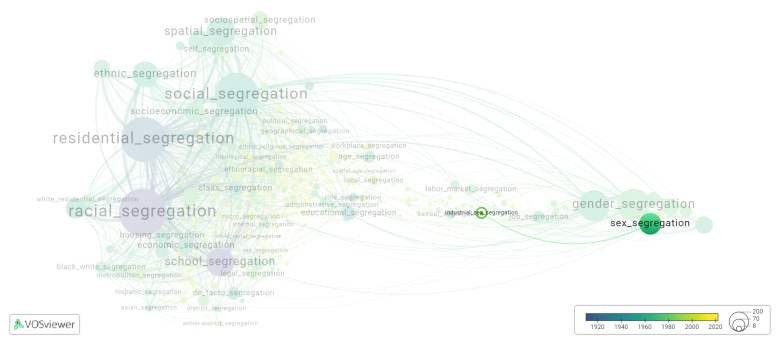Industrial sex segregation: Difference between revisions
(Creating page) |
(Creating page) |
||
| Line 12: | Line 12: | ||
References and literature addressing this segregation form under these synonymous terms can be found below. | References and literature addressing this segregation form under these synonymous terms can be found below. | ||
==See also== | ==See also== | ||
==Related segregation forms== | |||
Industrial sex segregation is frequently discussed in the literature with the following segregation forms: | |||
[[sex segregation]], [[occupational sex segregation]] | |||
[[File:industrial_sex_segregation.png|780x780px]] | |||
For the complete network of associated segregation forms, see: | |||
year of publication https://tinyurl.com/2235lkhw | |||
Louvain clusters https://tinyurl.com/2d8wg5n3 | |||
betweenness centrality https://tinyurl.com/223udk5r | |||
disciplines where segregation forms first appeared https://tinyurl.com/244d8unz | |||
==References== | ==References== | ||
==Notes== | ==Notes== | ||
Revision as of 14:35, 27 September 2024
Date and country of first publication[1]
1992
United States
Definition
Industrial sex segregation refers to the division of men and women into separate roles and occupations within a particular industry or workplace. This practice often leads to discrimination, unequal opportunities, and limited advancement for one gender over the other. In industrial settings, women are typically assigned to lower-paying, lower-skilled jobs, while men are more likely to hold positions of power and authority. This segregation perpetuates gender stereotypes and limits the potential for gender equality in the workplace. Efforts to reduce industrial sex segregation include promoting diversity and inclusion, providing equal access to training and advancement opportunities, and challenging traditional gender roles and expectations.
Synonyms
The following terms are synonymous with:
industry sex segregation.
References and literature addressing this segregation form under these synonymous terms can be found below.
See also
Related segregation forms
Industrial sex segregation is frequently discussed in the literature with the following segregation forms:
sex segregation, occupational sex segregation

For the complete network of associated segregation forms, see:
year of publication https://tinyurl.com/2235lkhw
Louvain clusters https://tinyurl.com/2d8wg5n3
betweenness centrality https://tinyurl.com/223udk5r
disciplines where segregation forms first appeared https://tinyurl.com/244d8unz
References
Notes
- ↑ Date and country of first publication as informed by the Scopus database (December 2023).
At its current state, this definition has been generated by a Large Language Model (LLM) so far without review by an independent researcher or a member of the curating team of segregation experts that keep the Segregation Wiki online. While we strive for accuracy, we cannot guarantee its reliability, completeness and timeliness. Please use this content with caution and verify information as needed. Also, feel free to improve on the definition as you see fit, including the use of references and other informational resources. We value your input in enhancing the quality and accuracy of the definitions of segregation forms collectively offered in the Segregation Wiki ©.
Industrial sex segregation appears in the following literature
Jacobs J.A., Lim S.T. (1992). Trends in Occupational and Industrial Sex Segregation in 56 Countries, 1960 1980. Work and Occupations, 19(4), 450-486. https://doi.org/10.1177/0730888492019004006
Rosenfeld R.A., Van Buren M.E., Kalleberg A.L. (1998). Gender Differences in Supervisory Authority: Variation among Advanced Industrialized Democracies. Social Science Research, 27(1), 23-49. https://doi.org/10.1006/ssre.1997.0609
Cook A., Minnotte K.L. (2008). Occupational and industry sex segregation and the work family interface. Sex Roles, 59(11-12), 800-813. https://doi.org/10.1007/s11199-008-9484-5
Minnotte K.L., Cook A., Minnotte M.C. (201). Occupation and industry sex segregation, gender, and workplace support: The use of flexible scheduling policies. Journal of Family Issues, 31(5), 656-680. https://doi.org/10.1177/0192513X09348593
